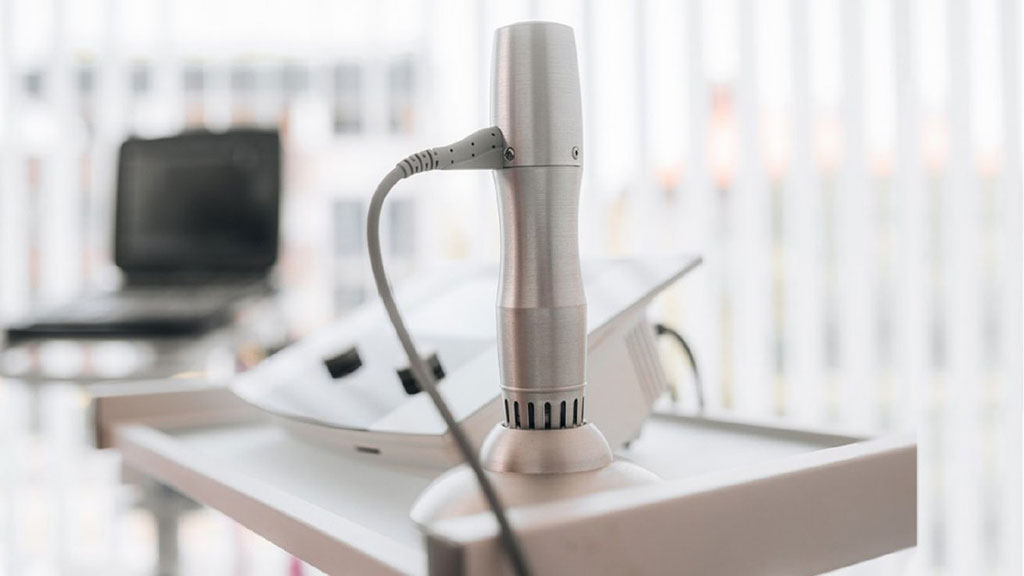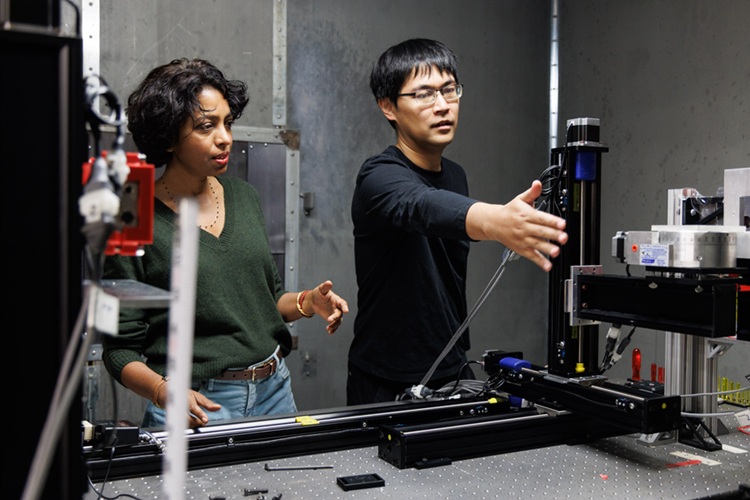Ultrasound-Guided Cancer Immunotherapy Platform Generates Systemic Antitumor Immunity
|
By MedImaging International staff writers Posted on 01 Jun 2022 |

Immunotherapy has transformed cancer treatment, offering clinical benefits for patients with treatment-refractory metastatic cancers such as melanoma, non-small cell lung cancer and renal cell cancer. However, not all patients respond to immune checkpoint blockade. Therefore, developing a more effective immunotherapy strategy to benefit larger numbers of cancer patients with localized and metastatic disease remains an unmet clinical need. Natural agonists, such as cyclic dinucleotides, activate the cGAS-STING pathway, but concerns over poor cytosolic entry, serum stability and systemic toxicity have been major limitations for clinical translation. To overcome these challenges, researchers have developed the first-ever image-guided cancer immunotherapy strategy that uses antibody targeting to activate STING in APCs through delivery of molecular drugs.
The ultrasound-guided cancer immunotherapy platform developed by researchers at The University of Texas MD Anderson Cancer Center (Houston, TX, USA) generates systemic antitumor immunity and improves the therapeutic efficacy of immune checkpoint blockade. As the first-of-its-kind platform, the Microbubble-assisted UltraSound-guided Immunotherapy of Cancer (MUSIC) approach employs nanocomplexes combined with microbubbles to effectively deliver cyclic guanosine monophosphate-adenosine monophosphate (cGAMP), an immunotransmitter involved in anticancer immunity, into antigen-presenting cells (APCs). Inside the APCs, the microbubbles release cGAMP to activate the GMP-AMP synthase (cGAS)-stimulator of interferon genes (STING) pathway, which stimulates type I interferon responses that are essential for priming tumor-specific T cells.
Because the microbubbles also serve as contrast agents for ultrasound, the researchers use ultrasound scanners to image the tumor and to precisely identify the location where the microbubbles have accumulated. After confirming the microbubbles are bound to the tumors, the researchers activate ultrasonic frequencies, which cause the microbubbles to oscillate and burst, creating transient pores in the cell membrane that allow nucleic acids to be transferred directly into the cell cytosol. This technique, called sonoporation, previously has been used on tumor cells, but the MUSIC platform is the first to bind nanocomplexes to microbubbles to deliver cGAMP immunotransmitters directly into APCs.
In the preclinical study, the MUSIC strategy demonstrated a complete tumor eradication rate of 60% when administered as monotherapy in breast cancer models. When combined with an anti-PD-1 antibody, MUSIC significantly improved antitumor responses with minimal toxicity effects, including enhanced primary tumor control and decreased systemic disease progression. In addition, the combination therapy demonstrated superior survival benefit, with a 76% increase in median survival compared to either therapy alone. The same concept and design principle behind the MUSIC platform’s microbubble technology could be readily translated to nanoscale systems for targeted systemic delivery and activation of innate immune sensors under image guidance for cancer immunotherapy applications, according to the researchers.
“The beauty of our platform is that ultrasound machines are already clinically available in many outpatient settings and microbubbles are FDA-approved contrast agents for ultrasound imaging,” said Wen Jiang, M.D., Ph.D., assistant professor of Radiation Oncology and the study’s co-senior author. “Therefore, we expect there is a very real opportunity to translate MUSIC into a clinic application to benefit cancer patients.”
“Our MUSIC platform is exciting because it provides a new framework for developing image-guided immunotherapy by using acoustically responsive biomaterials to enable efficient, targeted and robust immune activation to produce potent antitumor effects while minimizing systemic toxicity,” Jiang added. “The versatility of the MUSIC platform could potentially be applied to targeted delivery of other immune-stimulating agents, such as nucleotide-based vaccines, mRNAs and other gene therapies for multiple human diseases.”
Related Links:
MD Anderson Cancer Center
Latest Ultrasound News
- Wearable Ultrasound Imaging System to Enable Real-Time Disease Monitoring
- Ultrasound Technique Visualizes Deep Blood Vessels in 3D Without Contrast Agents
- Ultrasound Probe Images Entire Organ in 4D

- Disposable Ultrasound Patch Performs Better Than Existing Devices
- Non-Invasive Ultrasound-Based Tool Accurately Detects Infant Meningitis
- Breakthrough Deep Learning Model Enhances Handheld 3D Medical Imaging
- Pain-Free Breast Imaging System Performs One Minute Cancer Scan
- Wireless Chronic Pain Management Device to Reduce Need for Painkillers and Surgery
- New Medical Ultrasound Imaging Technique Enables ICU Bedside Monitoring
- New Incision-Free Technique Halts Growth of Debilitating Brain Lesions
- AI-Powered Lung Ultrasound Outperforms Human Experts in Tuberculosis Diagnosis
- AI Identifies Heart Valve Disease from Common Imaging Test
- Novel Imaging Method Enables Early Diagnosis and Treatment Monitoring of Type 2 Diabetes
- Ultrasound-Based Microscopy Technique to Help Diagnose Small Vessel Diseases
- Smart Ultrasound-Activated Immune Cells Destroy Cancer Cells for Extended Periods
- Tiny Magnetic Robot Takes 3D Scans from Deep Within Body
Channels
Radiography
view channel
AI Detects Early Signs of Aging from Chest X-Rays
Chronological age does not always reflect how fast the body is truly aging, and current biological age tests often rely on DNA-based markers that may miss early organ-level decline. Detecting subtle, age-related... Read more
X-Ray Breakthrough Captures Three Image-Contrast Types in Single Shot
Detecting early-stage cancer or subtle changes deep inside tissues has long challenged conventional X-ray systems, which rely only on how structures absorb radiation. This limitation keeps many microstructural... Read moreMRI
view channel
Novel Imaging Approach to Improve Treatment for Spinal Cord Injuries
Vascular dysfunction in the spinal cord contributes to multiple neurological conditions, including traumatic injuries and degenerative cervical myelopathy, where reduced blood flow can lead to progressive... Read more
AI-Assisted Model Enhances MRI Heart Scans
A cardiac MRI can reveal critical information about the heart’s function and any abnormalities, but traditional scans take 30 to 90 minutes and often suffer from poor image quality due to patient movement.... Read more
AI Model Outperforms Doctors at Identifying Patients Most At-Risk of Cardiac Arrest
Hypertrophic cardiomyopathy is one of the most common inherited heart conditions and a leading cause of sudden cardiac death in young individuals and athletes. While many patients live normal lives, some... Read moreNuclear Medicine
view channel
PET Imaging of Inflammation Predicts Recovery and Guides Therapy After Heart Attack
Acute myocardial infarction can trigger lasting heart damage, yet clinicians still lack reliable tools to identify which patients will regain function and which may develop heart failure.... Read more
Radiotheranostic Approach Detects, Kills and Reprograms Aggressive Cancers
Aggressive cancers such as osteosarcoma and glioblastoma often resist standard therapies, thrive in hostile tumor environments, and recur despite surgery, radiation, or chemotherapy. These tumors also... Read more
New Imaging Solution Improves Survival for Patients with Recurring Prostate Cancer
Detecting recurrent prostate cancer remains one of the most difficult challenges in oncology, as standard imaging methods such as bone scans and CT scans often fail to accurately locate small or early-stage tumors.... Read moreGeneral/Advanced Imaging
view channel
New Algorithm Dramatically Speeds Up Stroke Detection Scans
When patients arrive at emergency rooms with stroke symptoms, clinicians must rapidly determine whether the cause is a blood clot or a brain bleed, as treatment decisions depend on this distinction.... Read more
3D Scanning Approach Enables Ultra-Precise Brain Surgery
Precise navigation is critical in neurosurgery, yet even small alignment errors can affect outcomes when operating deep within the brain. A new 3D surface-scanning approach now provides a radiation-free... Read moreImaging IT
view channel
New Google Cloud Medical Imaging Suite Makes Imaging Healthcare Data More Accessible
Medical imaging is a critical tool used to diagnose patients, and there are billions of medical images scanned globally each year. Imaging data accounts for about 90% of all healthcare data1 and, until... Read more
Global AI in Medical Diagnostics Market to Be Driven by Demand for Image Recognition in Radiology
The global artificial intelligence (AI) in medical diagnostics market is expanding with early disease detection being one of its key applications and image recognition becoming a compelling consumer proposition... Read moreIndustry News
view channel
GE HealthCare and NVIDIA Collaboration to Reimagine Diagnostic Imaging
GE HealthCare (Chicago, IL, USA) has entered into a collaboration with NVIDIA (Santa Clara, CA, USA), expanding the existing relationship between the two companies to focus on pioneering innovation in... Read more
Patient-Specific 3D-Printed Phantoms Transform CT Imaging
New research has highlighted how anatomically precise, patient-specific 3D-printed phantoms are proving to be scalable, cost-effective, and efficient tools in the development of new CT scan algorithms... Read more
Siemens and Sectra Collaborate on Enhancing Radiology Workflows
Siemens Healthineers (Forchheim, Germany) and Sectra (Linköping, Sweden) have entered into a collaboration aimed at enhancing radiologists' diagnostic capabilities and, in turn, improving patient care... Read more










 Guided Devices.jpg)








